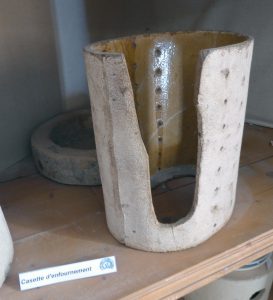

Saggars are usually made from grog or fire-clay. They belong to the large category of kiln furniture: objects in various shapes made for use in the kiln to support and protect the ceramic vessels during the firing process. Saggars were mainly used in wood- or coal-burning kilns to prevent the elaborately decorated ceramic objects from coming into direct contact with the flames, smoke and ash. That is why they were mainly used in historical faience and porcelain factories and not in the artisan production of earthenware. Cylindrical, oval and rectangular saggars of different sizes with triangular holes through which saggar pins could be inserted to support the objects were mainly used in the production of faience. Firing-rings of varying thickness and round cross-sections as well as round discs are types of saggar, which can be used in a variety of ways depending on the object fired.
On the other hand, saggars also allowed the delicate wares to be more efficiently stacked in the kiln, which was why they were used with increasing regularity in the production of both earthenware and stoneware over the course of the late 19th and 20th centuries.
On the other hand, saggars also allowed the delicate wares to be more efficiently stacked in the kiln, which was why they were used with increasing regularity in the production of both earthenware and stoneware over the course of the late 19th and 20th centuries.
Translation Sandy Haemmerle
German: Muffel (Brennkapsel, Kassette)
French: Gazette, étui, lanterne de terre, casette, cazette, manchon, casier réfractaire, moufle, cerce
References:
Blondel 2001
Nicole Blondel, Céramique, vocabulaire technique, Paris 2014, 172
Boschetti-Maradi 2006
Adriano Boschetti-Maradi, Gefässkeramik und Hafnerei in der Frühen Neuzeit im Kanton Bern (Schriften des Bernischen Historischen Museums 8), Bern 2006, 45-47.
Bourgarel 2007
Gilles Bourgarel, Fouilles archéologiques – La production, in: Marino Maggetti, La faïence de Fribourg: 1753-1844, Dijon 2007, 68-81, 126-157.
Maggetti 2007
Marino Maggetti, Technique de la faïence française (fin XVIIIe/debut XIXe siècle), in: Marino Maggetti, La faïence de Fribourg: 1753-1844, Dijon 2007, 14-31.
Matter 2012
Annamaria Matter, Die archäologische Untersuchung in der ehemaligen Porzellanmanufaktur Kilchberg-Schooren. Keramikproduktion am linken Zürichseeufer 1763-1906 (Monographien der Kantonsarchäologie Zürich 43), Zürich 2012, 65-77.

